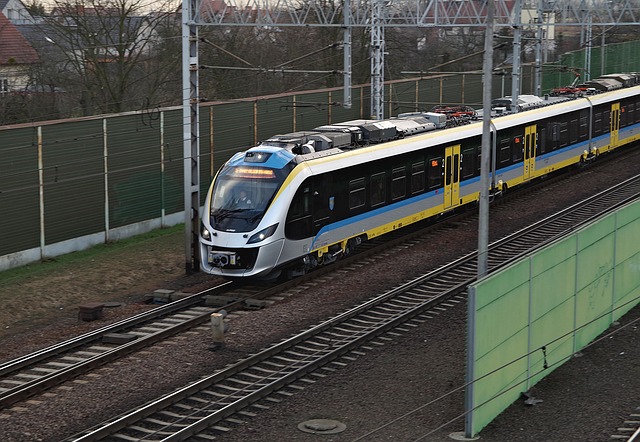Vehicle-to-Vehicle (V2V) communication technology enhances safety and efficiency on roads by enabling direct vehicle data exchange. Select vehicles transmit real-time info like speed, position, and brake status, improving situational awareness and reducing hazards. V2V also optimizes traffic flow, reduces congestion, and lowers emissions. Challenges include standardization, security, privacy, and public acceptance. Thoughtful implementation is crucial for realizing the future of smarter, safer transportation through V2V communication.
Modernize your commute with Vehicle-to-Vehicle (V2V) communication—a revolutionary technology transforming transportation. This article explores how V2V integration enhances safety by sharing real-time data between vehicles, preventing accidents, and streamlining traffic flow. Delve into the benefits, challenges, and future prospects of this game-changing tech, from smart city integration to a step-by-step guide for implementing select V2V communication in your daily routine.
- Understanding V2V Technology: How It Works
- Benefits of Vehicle-to-Vehicle Integration
- Enhancing Safety Through Real-Time Data
- Navigating Challenges: Implementation and Privacy
- Future of Transportation: Smart Cities and V2V
- Transforming Daily Commutes: Step-by-Step Guide
Understanding V2V Technology: How It Works

Vehicle-to-Vehicle (V2V) communication is a revolutionary technology that enables direct data exchange between cars, creating a smarter and safer driving environment. At its core, V2V involves select vehicles equipped with advanced radio frequency identifiers that transmit and receive information in real time. This technology allows vehicles to “talk” to each other, sharing data such as speed, position, direction, and even brake status.
By utilizing V2V, cars can detect potential hazards and give drivers advanced warnings, leading to reduced reaction times and improved safety. For instance, if a truck ahead suddenly brakes, V2V-enabled vehicles behind can receive this information immediately and respond accordingly. This technology also has significant implications for the future of connected cars, promising enhanced efficiency through coordinated driving, especially in scenarios like truck platooning, where multiple vehicles travel in formation to reduce fuel consumption and environmental impact. However, as with any communication system, security in V2V communications is paramount, requiring robust encryption and protocols to protect sensitive data from potential cyber threats.
Benefits of Vehicle-to-Vehicle Integration

Vehicle-to-Vehicle (V2V) integration is transforming the way we commute, offering a plethora of benefits that enhance both safety and efficiency on our roads. By enabling direct communication between vehicles, V2V technology creates a dynamic network where drivers can share real-time data about their positions, speeds, and even intended routes. This simple yet powerful exchange of information allows for improved situational awareness, making it easier to anticipate and react to potential hazards.
One of the most significant advantages is its role in congestion reduction strategies. With V2V communication systems, vehicles can collectively make informed decisions to optimize traffic flow. For instance, when several cars equipped with this technology are on a highway, they can coordinate their speed and braking patterns, reducing abrupt stops and minimizing bottlenecks. This not only improves overall commute times but also contributes to lower fuel consumption and reduced environmental impact. The networked vehicles benefits extend beyond individual drivers, fostering a smoother, safer, and more interconnected transportation system.
Enhancing Safety Through Real-Time Data

Vehicle-to-Vehicle (V2V) communication technology is transforming the way we commute, prioritizing safety in the process. By enabling direct data exchange between vehicles, V2V integration creates a network of real-time information that enhances overall road safety. This advanced system allows for instant alerts and warnings about potential hazards, such as sudden stops or obstacles on the road ahead. For example, if a vehicle equipped with V2V technology detects an imminent collision, it can send signals to nearby vehicles, enabling them to take evasive actions or prepare for impact.
This innovative approach to safety goes beyond individual vehicle protection. The shared real-time data contributes to a more comprehensive understanding of traffic patterns and environmental factors that influence road conditions. As the adoption of connected car technology grows, the future of V2V integration promises even greater improvements in safe vehicle interactions, potentially reducing accidents caused by human error or poor judgment. Moreover, the environmental impact of V2V could be significant, as optimized routes and reduced congestion lead to lower emissions and a greener transportation network.
Navigating Challenges: Implementation and Privacy

Navigating Challenges: Implementation and Privacy
Implementing Vehicle-to-Vehicle (V2V) communication technologies presents a complex web of challenges, particularly when considering integration within existing infrastructure. The first hurdle lies in standardization; with various vehicle manufacturers adopting different protocols, ensuring seamless V2V interaction across diverse makes and models is no simple task. Additionally, the security and privacy concerns surrounding V2V data exchange cannot be overlooked. As vehicles become increasingly connected, protecting sensitive information from cyber threats becomes paramount, especially when sharing real-time location and speed data.
Privacy remains a critical aspect that demands meticulous attention. While V2V technology promises enhanced safety and traffic flow, it also raises questions about who has access to this data and how it’s used. Striking a balance between reaping the benefits of intelligent transportation systems (ITS) and safeguarding personal privacy is essential for public acceptance. Furthermore, considering the potential implications on congestion reduction strategies, it’s imperative that V2V communication be implemented thoughtfully, ensuring both safety and efficiency without compromising individual privacy rights.
Future of Transportation: Smart Cities and V2V

The future of transportation is looking smarter and more interconnected than ever before. Smart cities are at the forefront of this revolution, leveraging technology to enhance mobility and create more efficient, sustainable, and safe transportation systems. At the heart of this transformation lies Vehicle-to-Vehicle (V2V) Communication – a game-changer that promises to revolutionize how we navigate our daily commutes.
By enabling direct communication between vehicles, V2V technology facilitates inter-vehicle sensing systems, promoting real-time data exchange on speed, position, and intentions. This not only enhances pedestrian safety measures but also enables transportation infrastructure upgrades through better traffic flow management. Furthermore, the integration of V2V communication can significantly contribute to energy efficient transportation by reducing congestion and optimizing routes, ultimately leading to a greener and more livable urban environment.
Transforming Daily Commutes: Step-by-Step Guide

Transforming Daily Commutes: Step-by-Step Guide
The future of commuting is here with Vehicle-to-Vehicle (V2V) communication technology, revolutionizing how we navigate our daily travels. By enabling direct vehicle-to-vehicle messaging, this innovation promises safer roads and smoother journeys. Here’s a breakdown to help you understand the process:
1. Select Your V2V System: With various options available, choose a system that suits your needs. Modern V2V solutions offer real-time data exchange, allowing vehicles to communicate potential hazards, road conditions, and even predict traffic patterns.
2. Integration and Compatibility: Ensure your vehicle is equipped with the necessary hardware for seamless integration. Many modern cars already have the required components, making retrofitting easier. Smart grid integration urban mobility solutions benefit from this technology, enhancing overall efficiency.
3. Secure Communication: V2V data exchange must be secure to protect privacy. Advanced encryption techniques are employed to safeguard personal information while ensuring clear communication between vehicles.
4. Practice and Adapt: Once implemented, drivers need to adapt to the new system. Practicing safe driving habits alongside V2V technology is key. Remember, these steps contribute to a future where roadside communication systems and market trends in automotive networking merge, creating a more efficient, connected, and ultimately safer commuting experience.
Modernizing your commute is no longer a distant dream but an achievable reality thanks to Vehicle-to-Vehicle (V2V) communication technology. By enabling direct vehicle-to-vehicle interactions, V2V integration enhances safety, reduces congestion, and improves efficiency in today’s digital era. As we move forward, smart cities powered by V2V technology will redefine urban transportation, making daily commutes smoother, safer, and more connected. Embracing this innovative approach can transform your typical journey into a seamless, stress-free experience.
